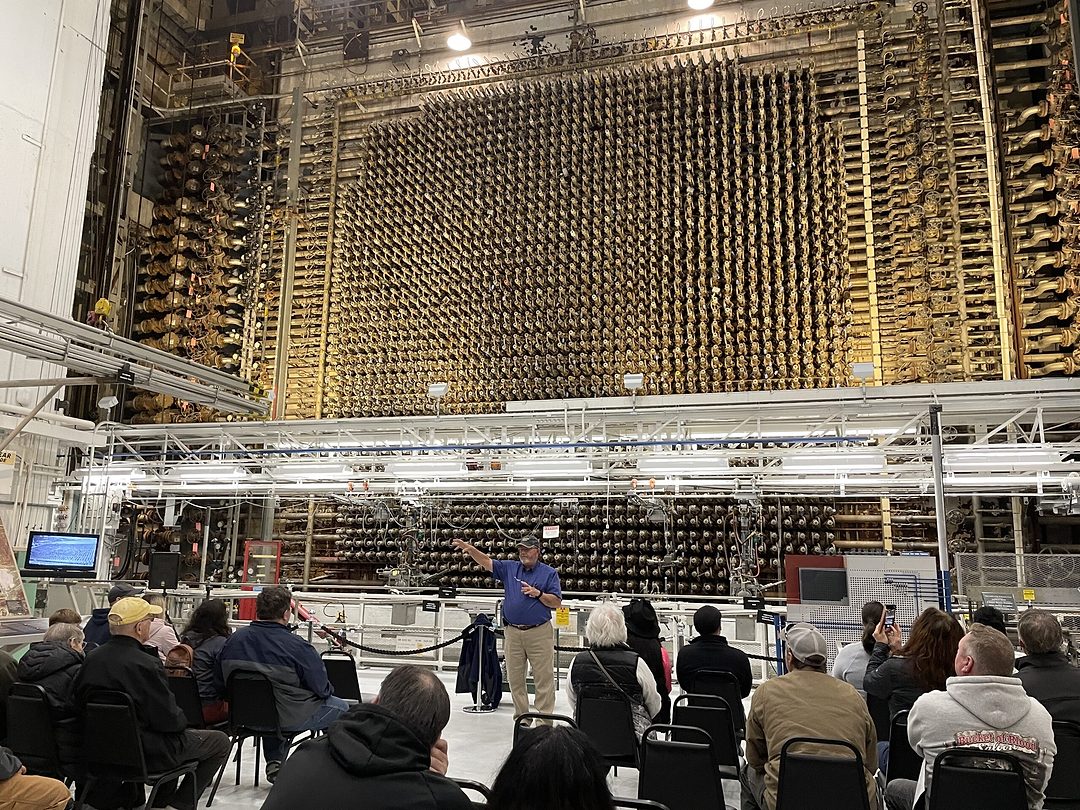
Home » B Reactor tours filling up fast in last season before two-year closure
B Reactor tours filling up fast in last season before two-year closure
Two-year closure begins this fall for upgrades, preservation work

Visitors listen to the history of the B Reactor while standing before the front face of the plutonium reactor at the Hanford site. B Reactor produced the plutonium used in the bomb dropped on Nagasaki, Japan, in 1945.
Photo by Kristina LordMarch 15, 2024
The Hanford nuclear site’s only attraction open to visitors is set to close later this fall for two years to get some much-needed preservation repair work.
Before then, however, visitors can book tours from now through June and potentially into this summer, depending on when the scheduled work begins.
The B Reactor, one of the plutonium-producing reactors on the Hanford nuclear site, became operational in 1944. After a brief restart in production during the Cold War, the B Reactor shut down permanently in 1968.
The site was designated as a historical landmark and is part of the Manhattan Project National Historical Park, which was established in 2014. It is operated by the U.S. Department of Energy and the National Park Service.
It has been open to the public for tours since 2009, but some things are due for much-needed repairs to preserve it.
The B Reactor building needs a new roof and to be resealed to prevent water from getting into the facility, said Colleen French, program manager at the Manhattan Project National Historical Park.
Additionally, the B Reactor is currently using its World War II-era electrical system, which was scaled to run the reactor at one time, so the Department of Energy is putting in a more efficient electrical system to maintain the building.
French said the new electrical system will make it easier to maintain the reactor since they have to secure replacement parts for the current electrical system from other reactors since those parts aren’t produced anymore.
The B Reactor also will have a semi-permanent restroom facility after its remodel, which will make the experience much more pleasant for visitors.
Movie drives demand
The release of the “Oppenheimer” movie last summer led to a surge in interested visitors at the Hanford visitor center and people interested in booking a tour of the reactor. After the site announced its impending closure, tours filled up in a matter of days.
With demand so high and the lag between planning and actual preservation work beginning, DOE decided to open the site for tours this spring.
Tours will restart March 29 and run through June. If possible, tours for July and August also will be opened a month in advance.
The B Reactor will be open on holiday weekends including Memorial Day and the Fourth of July as well as on weekends to meet the increased demand.
A typical tour can accommodate about 45 people, French said.
In 2023, the B Reactor site had visitors from 49 states and nearly 40 different countries. Even within Washington state, there were visitors from dozens of different counties, French said.
“It underscores what a business opportunity it is for our community,” she said.
Preserving B Reactor
When the Hanford site was fully operational during the WWII era, there were nine reactors positioned along the Columbia River to produce plutonium, the key and lethal ingredient in nuclear weapons being developed by the United States.
Plutonium created in the B Reactor was used in the Trinity Test in New Mexico, which is depicted in “Oppenheimer,” as well as in the nuclear weapon the U.S. dropped on the Japanese city of Nagasaki, killing 226,000 people there and effectively ending the war.
The reactors used energy generated by the then-recently constructed Grand Coulee Dam to operate and river water helped cool off the reactors as they produced plutonium in aluminum processing tubes that contained uranium fuel slugs.
The chemicals were piped about 10 miles south of the reactor to the center of the Hanford site where the processing canyons are, French said, and where the plutonium was formed at the time.
Some of the waste went into tank farms, other waste was buried, and some liquid waste was left in shallow areas in the ground to dissolve. Cleanup on other parts of the Hanford site continues to this day.
Seven of Hanford’s reactors have been “cocooned,” or disassembled to the point they can be without risking exposure. They have 75-year roofs installed and have been left for the waste to decay before the rest of cleanup is done.
The B Reactor will be preserved, and K-West Reactor is still in the process of being cocooned.
There is no plutonium present in the B Reactor, but there is still contamination in its interior, French said.
The Department of Energy monitors the site and conducts daily surveys, with sampling in coordination with the health department for radioactivity. The contamination inside the reactor cannot be cleaned up because it is so deep in its interior, French said.
There is still time to see the B Reactor before it is closed to the public for about two years.
Nearly 1,200 tour seats had been claimed by March 4, when this year’s tour dates opened, and the first weekend, March 29-30, is completely booked already.
Register online in advance at manhattanprojectbreactor.hanford.gov.
Latest News Hanford Hospitality & Meetings
KEYWORDS March 2024
Related Articles




